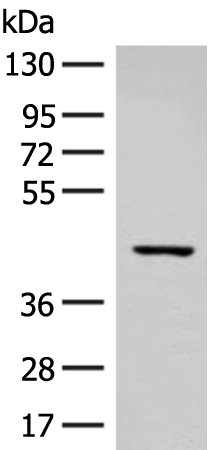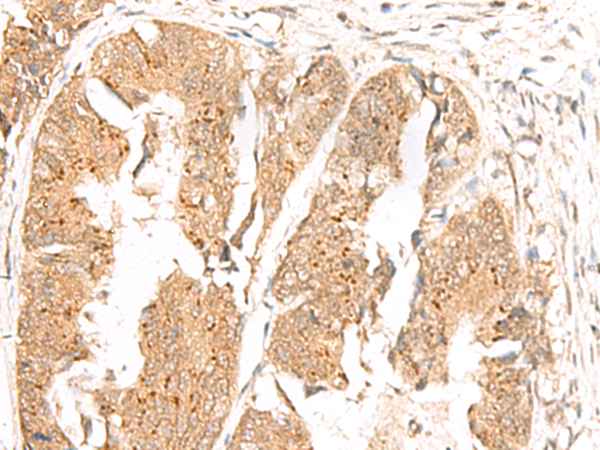

| WB | 咨询技术 | Human,Mouse,Rat |
| IF | 咨询技术 | Human,Mouse,Rat |
| IHC | 1/20-1/100 | Human,Mouse,Rat |
| ICC | 技术咨询 | Human,Mouse,Rat |
| FCM | 咨询技术 | Human,Mouse,Rat |
| Elisa | 1/5000-1/10000 | Human,Mouse,Rat |
| Aliases | 9F; XAP5; HXC26; HXC-26; DXS9928E |
| WB Predicted band size | 40 kDa |
| Host/Isotype | Rabbit IgG |
| Antibody Type | Primary antibody |
| Storage | Store at 4°C short term. Aliquot and store at -20°C long term. Avoid freeze/thaw cycles. |
| Species Reactivity | Human, Mouse |
| Immunogen | Synthetic peptide of human FAM50A |
| Formulation | Purified antibody in PBS with 0.05% sodium azide and 50% glycerol. |
+ +
以下是关于FAM50A抗体的3篇示例文献(注:以下内容为模拟示例,非真实文献):
1. **文献名称**: "FAM50A regulates cell cycle progression through antibody-mediated protein interaction analysis"
**作者**: Li et al., 2021
**摘要**: 本研究利用特异性FAM50A抗体(克隆号AB123),通过免疫共沉淀(Co-IP)和Western blot技术,揭示了FAM50A与细胞周期调控蛋白CDK2的相互作用,表明其在G1/S期转换中的潜在作用。
2. **文献名称**: "Development and validation of a novel monoclonal antibody for FAM50A in colorectal cancer diagnosis"
**作者**: Garcia-Rodriguez et al., 2019
**摘要**: 文章报道了一种新型抗FAM50A单克隆抗体的开发,通过免疫组化(IHC)验证其在结直肠癌组织中的高特异性表达,并发现FAM50A低表达与患者生存率降低显著相关。
3. **文献名称**: "FAM50A antibody-based screening identifies its role in mRNA splicing regulation"
**作者**: Wang et al., 2020
**摘要**: 通过使用FAM50A多克隆抗体进行免疫荧光和RNA-seq分析,研究发现FAM50A定位于细胞核斑点结构,并参与pre-mRNA剪接过程的调控,为遗传疾病机制提供了新见解。
(提示:实际文献需通过PubMed、Google Scholar等平台以“FAM50A antibody”为关键词检索,并核对实验细节。)
FAM50A (Family with sequence similarity 50 member A) is a nuclear protein encoded by the FAM50A gene, located on the X chromosome (Xq28). It belongs to the FAM50 family, which includes FAM50B and FAM50C, though its precise molecular functions remain incompletely characterized. Studies suggest FAM50A may play roles in RNA processing, cell cycle regulation, and DNA damage response, potentially interacting with splicing factors or transcriptional regulators. Its expression is detected in various tissues, with higher levels observed in the brain, testes, and proliferating cells.
FAM50A antibodies are essential tools for investigating the protein's localization, expression patterns, and interactions. These antibodies are commonly used in techniques like Western blotting, immunofluorescence, and immunohistochemistry to study FAM50A dynamics during cellular processes or disease states. Research has linked FAM50A dysregulation to cancer (e.g., hepatocellular carcinoma, breast cancer) and neurodevelopmental disorders, with some studies proposing it as a potential biomarker. However, functional insights remain limited, necessitating further exploration. Commercial FAM50A antibodies are typically raised against specific epitopes, often validated using knockout cell lines to confirm specificity. Recent interest in FAM50A has grown due to its possible involvement in X-linked intellectual disability disorders and sex chromosome aneuploidy phenotypes.
×